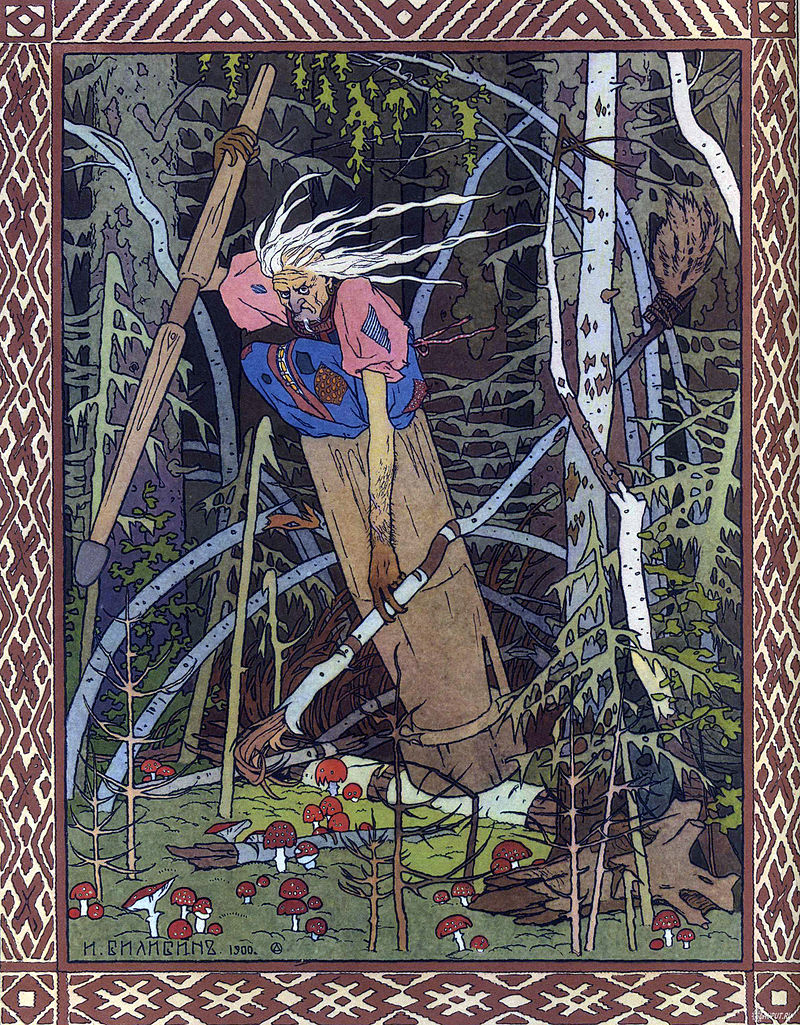Baba-Yaga: Man-Eating ’Grandma Witch’ of Russia
Baba-Yaga, Russian for "grandma witch," is a term that comes from Soviet fairy tales. Sometimes the title is used in the sense of a 'wise woman' or 'older woman with magic'; sometimes it is used to describe a type of character, such as in tales where we are told 'three baba-yagas lived together'; but most often it is used as the name for a particular insidious and monstrous witch woman who often is either the main villain or a major threat within the tales she inhabits. The monstrous witch Baba-Yaga is most often tall and skinny -- skinny as a skeleton -- and possesses not only a hunger for human flesh, but the capacity to consume enough food for twelve at one sitting... or a whole human being, if anyone is that unlucky.

Baba-Yaga flies through the forest. For a larger version, Click Here.
Baba-Yaga the monster is a favorite villain in Russian folktales, and her situation and abilities vary from story to story. Sometimes, for example, she roams the dark forests of Russia in a chicken-legged house; in other tales she lives in a hut with a fence made up of the bones of those she has eaten, topped with their skulls. Baba-Yaga is said to fly low through the dark woods sitting on a magic mortar, steering with her pestle, and using a broom to cover up any trail she may leave; and anybody she runs across on these flights is in danger of joining her for dinner (not in a good way). Baba-Yaga’s chicken legged hut is said to have no obvious doors or windows ― Baba-Yaga enters through the chimney ― but the door is merely hidden, always turned away from those seeking it unless they ask properly: “Hut, turn your back to the woods, and face me.“
Baba-Yaga knows things no one else could guess, so she can help people; and, depending on if she's the wise woman or the monster, her help may come at the price of an impossible task, with death as the punishment for failure. While most faced with such a task or trapped against their will by Baba-Yaga only escape due to outside magical assistance, a clever few people in the stories trick Baba-Yaga into defeating herself, turning her own traps and magic back on her.
The tales of Baba-Yaga circulated orally in Russia for an unknown length of time before they started to be collected. Most of the tales that were later translated to English to give foreign cultures their first taste of this stunning character, had been collected along with nearly 600 other Russian tales by Alexander Nikolayevich Afansayev between 1855 and 1867; for this astounding accomplishment, Afanasyev has been called the Russian counterpart to the famous Brothers Grimm.
Below I present a number of Russian folk-tales -- both well-known and not -- that show Baba-Yaga in both her aspects: as the wise woman and, sometimes, the monster.
Related Incidents:
Anomalies -- the Strange & Unexplained, as well as my other website -- Monsters Here & There -- are supported by patrons, people like you! All new Anomalies articles are now posted for my patrons only, along with exclusive content made just for them. You can become a patron for just $1 a month!
|








